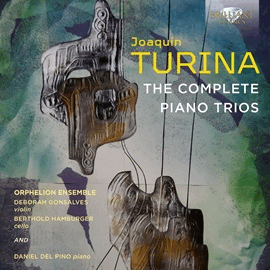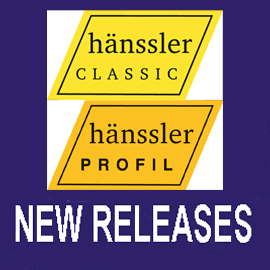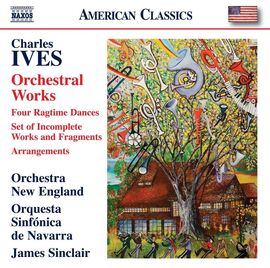Charles Ives ist beispielsweise mit seinen Symphonien bekannt und wegen sich überlagernder Strukturen darin bei vielen als Schreckgespenst verschrien. Auf diesem Album findet sich eine Übung dazu in ‘The Gong on the Hook and Ladder or Firemen’s Parade Down Main Street‘, wo Ives als ein Experiment mit der Regelmäßigkeit des Läutens der Feuerglocke und der unterschiedlichen Geschwindigkeit des Feuerwehrautos hantierte. Im Programm gibt es weitere kurze Werke, die man mitunter fast als Witz oder Scherz verstehen mag. Das nimmt vielleicht nicht den Schrecken, ermöglicht aber einen vielseitigen Höreindruck. Und den Blick in die Entwicklung von Ives. Die Werke mussten teilweise noch eingerichtet werden.
Es lassen sich Vorlieben von Ives hören. Seine Four Ragtime Dances basieren jeweils auf drei Hymnenmelodien. Mit der Gegenüberstellung von Heiligem und Profanem wird seine Suche nach der Einheit aller Menschen markiert. Mit der Fuge in vier Tonarten ärgerte Ives seine Professoren in Yale.
Chromâtimelôdtune ist eine seiner erstaunlichsten Schöpfungen, mit der er sich über europäische Einflüsse lustig machte, indem er eine kantige 12-Ton-Melodie und zwei sechs-stimmige Akkordkonstruktionen in witziger Weise nutzte und zu einem Höhepunkt auf einem C-Dur-Akkord steigerte.
Dazu kommen aus seiner Studienzeit Bearbeitungen von klassischen Kompositionen, die die anregend eigenwillige Handschrift zeigen, ohne deswegen die Vorlagen zu übertünchen. Nur die drei vollständigsten Skizzen auf Werke von Schubert und Schumann wurden eingespielt.
Die Auswahl wird von zwei Orchestern gespielt. Die eigenen Stücke präsentiert das kleiner besetzte Orchestra New England raffiniert und strukturiert. Die drei Bearbeitungen klassischer Werke werden vom Orquesta Sinfónica de Navarra dargestellt. Bei allen wirkt James Sinclair, der auch für die Bearbeitungen mitverantwortlich zeichnet, als Dirigent mit. Ihm gelingt es, die Effekte der Kompositionen nicht über Gebühr auszureizen, sondern eine abgestufte Darstellungsweise zu finden, die Groteskes, Ironisches und Nostalgisches herausstellt. Auch ohne aggressive Formulierung können die Interpreten Spannungen und Farben zu erkennen geben.
Charles Ives is well known for his symphonies, which many people regard as a spectre because of the overlapping structures in them. This album contains an exercise in this in ‘The Gong on the Hook and Ladder or Firemen’s Parade Down Main Street’, where Ives experimented with the regularity of the ringing of the fire bell and the varying speeds of the fire engines. This recording introduces other short works, some of which might almost be taken as a joke or jest. This may not take away the horror, but it makes for a varied listening experience. And a glimpse into Ives’ development. Some of the works still had to be arranged.
Ives’ preferences can be heard. His Four Ragtime Dances are based on three hymn melodies each. The juxtaposition of the sacred and the profane marks his search for the unity of all people. With the fugue in four keys, Ives annoyed his professors at Yale.
Chromâtimelôdtune is one of his most astonishing creations, in which he poked fun at European influences by making witty use of an angular 12-note melody and two six-part chord constructions, building to a climax on a C major chord.
In addition, there are arrangements of classical compositions from his student days, which show his stimulatingly idiosyncratic handwriting, without whitewashing the originals. Only the three most complete sketches for works by Schubert and Schumann have been recorded.
The selection is played by two orchestras. The smaller Orchestra New England presents his own pieces in a refined and structured manner. The three arrangements of classical works are performed by the Orquesta Sinfónica de Navarra. James Sinclair, who is also jointly responsible for the arrangements, conducts all of them. He succeeds in not overdoing the effects of the compositions, but in finding a graduated way of presenting them that emphasizes the grotesque, the ironic and the nostalgic. Even without aggressive phrasing, the performers are able to reveal tensions and colors.


















